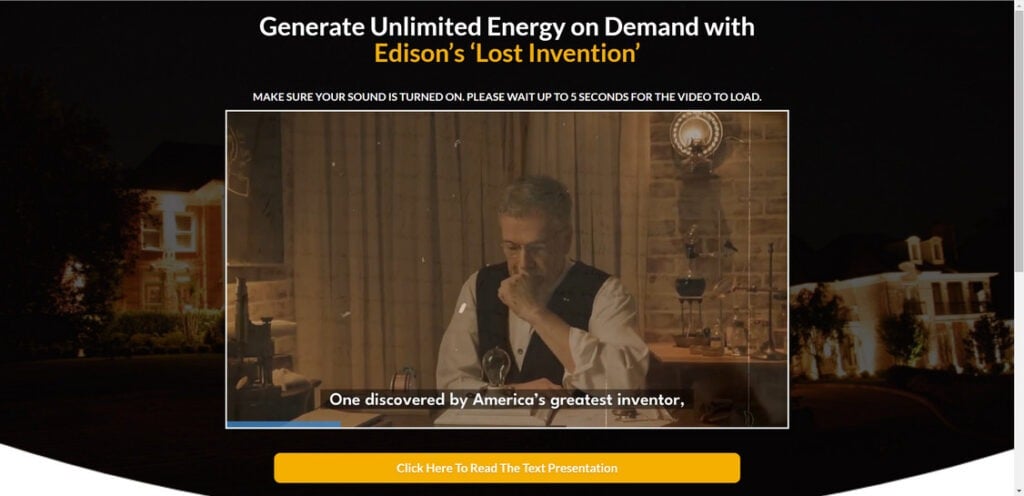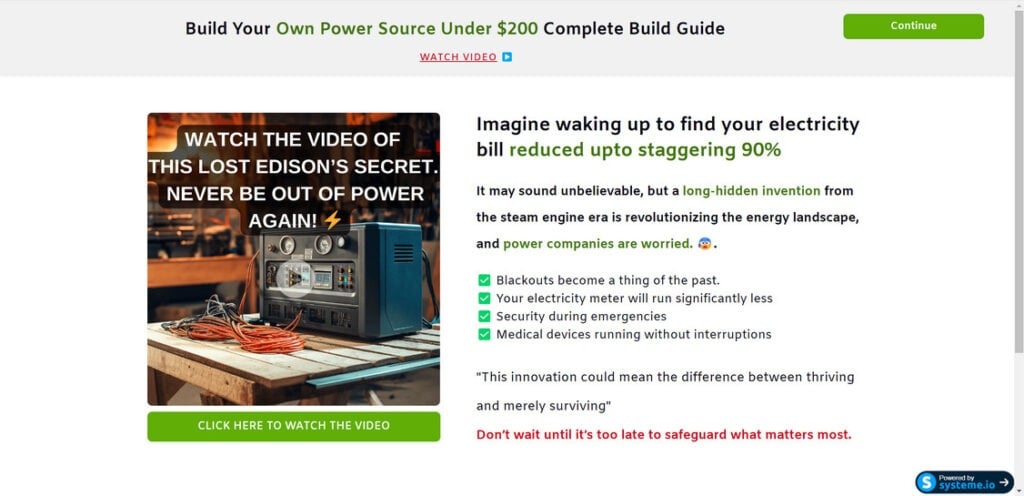A new online product called the Edison Lost Generator Plans has been gaining a lot of attention lately, with advertisements claiming it can help people build their own power generators to reduce or eliminate their electricity bills. However, many people are questioning the legitimacy of these plans and wondering if it is actually a scam designed to take advantage of consumers.
In this comprehensive article, we will take an in-depth look at the Edison Lost Generator Plans to determine if they are legit or a scam. We will cover what the product claims to offer, analyze how the scam works for those who have fallen victim to false promises, provide advice for avoiding these types of scams, and offer a definitive conclusion on whether the Edison Lost Generator Plans are worth your time and money.


Overview of the Scam
The Edison Lost Generator Plans scam works by utilizing false advertisements and misleading claims to convince consumers to purchase poorly designed and incomplete generator plans that do not live up to promises.
How the Scam is Advertised
The advertisements for the Edison Lost Generator Plans appear online through social media platforms like Facebook, TikTok, and YouTube. They often begin with a video or image of an elderly man claiming to have built his own generator which allows him to stop paying electricity bills.
Other actors appear and make exaggerated claims that the plans will allow consumers to build generators that can produce free, unlimited energy. The ads claim the instructions are being sold for a one-time low payment of $59 or less.

False Promises and Misleading Claims
Here are some of the common false promises and exaggerated claims made in the Edison Lost Generator Plan advertisements:
- Ability to produce unlimited, free electricity with a homemade generator
- No need to ever pay an electricity bill again after building the generator
- Step-by-step plans contain all information needed to easily build a working generator
- Big energy companies don’t want consumers to know about this revolutionary generator technology
- Consumers can make money selling excess energy back to utility companies
- The generator plans are being sold by an elderly man; not a faceless corporation
In reality, none of these claims hold up to scrutiny, as we will explore next. They are fabricated to get consumers excited about the supposed potential of building your own generator.

How the Edison Lost Generator Plans Scam Actually Works
While the advertisements make bold claims about the usefulness and ease of building a generator with their plans, the actual product does not live up to these promises. Here is an inside look at how the scam works:
The Product
Once purchased, customers gain access to a set of online articles that barely pass as generator plans. They consist of vague, generic information and lack the specific steps, diagrams, and part lists that would actually be needed to construct a working generator.
Often, the instructions simply mention general components like “battery system” or “charge controller” without any directions on which parts and brands to purchase. There are no schematics, wiring diagrams, or adequate explanations for how to convert energy sources like solar, wind, or kinetic energy into electricity.
Affiliate Marketing Scheme
The Edison Lost Generator Plans are primarily sold through affiliate marketing schemes in which websites earn commissions for promoting and selling the product. This allows the creators to escape responsibility for any false claims or returns. The product is unlikely to ever be seen on a reputable retail site.
Refund Difficulties
While advertisements claim there is a 60-day refund policy, the actual process for getting a refund is convoluted and difficult. Many customers report never receiving refunds despite multiple attempts to contact the company. The lack of an actual product and the affiliate marketing system essentially removes any accountability.
Results Not Guaranteed
The Edison Lost Generator Plan website and terms of use state that results from using the plans are not guaranteed. This contradicts the miraculous results touted in the ads and demonstrates how little faith the sellers have in the product.
By understanding how the scam actually functions, it becomes evident that the Edison Lost Generator Plans do not provide a legitimate product or value. The following sections will provide recommendations on avoiding these scams in the future.
What to Do if You Have Fallen Victim to the Scam
If you already purchased the Edison Lost Generator Plans and realized it was a scam, here are some steps to take:
- Contact your credit card company or payment provider: Notify them that the product was misrepresented and request the charges be reversed. Provide specifics on how the actual product differed from the advertised claims.
- Report the false advertising: File complaints with the FTC, state attorney general, and BBB to get the word out about fraudulent claims and prevent others from being scammed.
- Leave online reviews: Post honest reviews about your experience to warn potential victims on sites like Trustpilot and social media. This helps counteract fake positive reviews.
- Seek additional refund opportunities: Some payment providers like PayPal have refund policies that allow you to get money back if a product differs substantially from its description.
- Be wary of spending more money: Often the scam operators will offer additional products or services to try to squeeze more money out of victims. Avoid throwing good money after bad.
- Guard personal information: Do not provide sensitive info like copies of ID to shady merchants. Use prepaid cards when possible for purchases.
- Learn from the experience: Use this as a lesson to be more skeptical of outrageous claims made in advertising and carefully research products before buying in the future.
The Bottom Line: Are the Edison Lost Generator Plans Legit or A Scam?
Given the complete analysis of how the Edison Lost Generator Plans operate, there is an obvious conclusion:
The Edison Lost Generator Plans are a scam designed to take advantage of consumers, with no ability to actually deliver on advertised claims.
Avoid falling for the exaggerated marketing and false promises. The incomplete instructions have no educational value and do not allow someone to build a working generator from scratch. Additionally, getting a refund is made intentionally difficult.
Unless you want to end up losing your money for minimal information, it’s best to stay far away from the Edison Lost Generator Plans and learn how to spot similar scams moving forward. Don’t become a victim to the predatory affiliate marketing schemes.
Frequently Asked Questions About the Edison Lost Generator Plans
1. What exactly are the Edison Lost Generator Plans?
The Edison Lost Generator Plans are a digital product being advertised and sold online as a way for consumers to build their own electricity generator at home. The ads promise that the generator can produce unlimited free energy and allow you to stop paying electric bills. However, the actual product is a set of poorly written online articles that lack the detailed instructions needed to construct a working generator.
2. How do the ads work to lure in victims?
The ads are usually YouTube videos or social media posts featuring paid actors making false claims about being able to build a generator easily using the plans. They feature an elderly man claiming he built a generator that made his electricity free. The ads state the plans are being sold directly by this man to help others, when in reality it is an affiliate marketing scheme.
3. What sort of false promises are made in the ads?
Some of the exaggerated and false claims made include that the generator plans will produce unlimited free electricity, allow you to stop paying electric bills, contain step-by-step instructions anyone can follow, and are being sold directly by an elderly man rather than a faceless corporation.
4. Why can’t the plans actually help you build a generator?
The articles are vague and lack key details like wiring diagrams, specific parts lists, and explanations for converting energy sources to electricity. There are no custom schematics. The instructions are incomplete and would not allow a beginner to successfully build their own generator.
5. How hard is it to get a refund?
Getting a refund is intentionally made very difficult. The affiliate marketing scheme helps the creators avoid responsibility. Many customers report being unable to get their money back despite the advertised refund policy.
6. Are the generators guaranteed to work if I build one?
No, the website terms and conditions state that results are not guaranteed. This shows how little faith the creators have in the product and contradicts the miraculous results mentioned in the ads.
7. Why is this considered a scam?
The exaggerated claims are completely false and impossible. The product does not match the advertised claims, lacks real value, and getting money back is difficult. The entire business model is designed to take advantage of consumers. This matches the definition of an online scam.
8. What steps should I take if already victimized?
First, contact your payment provider about reversing the charges since the product was misrepresented. File official complaints and leave negative reviews to warn others. Do not provide personal info if asked. Learn to spot the red flags of a scam next time.
9. Is there any reason I should buy the Edison Lost Generator Plans?
No, there is no reason to purchase this product. You will not be able to build a working generator from the vague instructions. Save your money and avoid this scam.
Final Thoughts
Approaching seemingly amazing products with skepticism can protect you from empty promises and outright scams. If an offer appears too good to be true, it almost always is. Make sure to thoroughly research a product and look for unbiased reviews of real customer experiences.
Seeking great value is reasonable, but understand that there are no magic solutions that can circumvent the laws of physics and economics. Safeguard yourself by avoiding unbelievable claims about unlimited free energy. Hopefully this article has provided useful insights to recognize and avoid similar scams as you come across them.
This article is for educational purposes only and does not constitute professional, financial or legal advice. The content is intended for general information and should not be construed as definitive guidance. Information contained herein is subject to change without notice. For concerns, please contact us via the provided form. If you are the owner of the website or product in question and wish to offer clarifications regarding your business or website, please reach out to us through the provided Contact Form.










